Axminster Trade Series User manual

MT25
Floor Standing
Morticer
Code 501208
AT&M: 22/04/2014
REF: 508305

Index of Contents
2
Index of Contents 02
Declaration of Conformity 02
What’s Included 03
General Safety Instructions for 230V Machines 03-04
Specific Safety Instruction for Morticers 04
Specification 04
Unpacking and Assembly 05-06
Illustration and Parts Description 07-08-09
Setting Up the Morticer 10-11-12-13-14
Accessories 15-16
Maintenance 16-17-18-19
Troubleshooting 20
Exploded Diagram/List 21-22
Wiring Diagram 23
Declaration of Conformity
Copied from CE Certificate
The undersigned, authorised by Zhu Shaohua
by Qingdao Capital Resource Electric Co., Ltd.No. 155
Zhuzhou Road, Qingdao 266101, China
Model Number MT25
Manufactured Qingdao Capital Resource Electric Co., Ltd.
is in compliance with the standards determined in the
following Council Directive.
2006/42/EC Machinery Directive
2004/108/EC EMC Directive (Electro Magnetic
Compatibility)
2006/95/EC Low Voltage Directive
2002/96/EC RoHS Directive (Reduction of Hazardous
Substances)
Designed in consideration of the standards
EN 61029-1:2009
Warning The symbols below advise that you follow
the correct safety procedures when using
this machine.
Fully read manual
and safety
instructions
before use
Eye protection
should be worn
Ear protection
should be worn
HAZARD
Motor gets hot
Two Man AssemblyDust mask
should be worn

What’s Included
3
Good Working Practices/Safety
The following suggestions will enable you to observe
good working practices, keep yourself and fellow
workers safe and maintain your tools and equipment
in good working order.
Quantity Item Part Model Number
MT25
1 No MT25 Morticer A
1 No Operating Lever B
1 No Cabinet C
2 No 3-4mm Hex Keys D
1 No Chuck Key E
2 No Bush Adaptors 1.3/16" and 13/16" F
1 No Instruction Manual
WARNING!! KEEP TOOLS AND EQUIPMENT OUT
OF THE REACH OF YOUNG CHILDREN
Electrical Safety
• The machine is not designed for working outside, do not
use when or where it is liable to get wet.If the machine
does get wet; dry it off as soon as possible with a cloth or
paper towel.
• Do not use 230V a.c. powered machines anywhere
within a site area that is flooded or puddled, and
do not trail extension cables across wet areas.
• Check that the mains power supply is earthed.
• Regularly check the mains lead and plug for damage.
• Ensure that a fuse of the correct amperage is tted to
the plug.
• Ensure that any extension lead used is correctly rated
to suit the machine or power tool.
• Ensure that the power lead and any extension lead is
kept clear of the blades or other sharp obstacles.
• Do not use electrical machines or power tools in wet
or damp areas or locations .
• If a replacement mains plug is tted at any time, this
must be of the appropriate size and fitted with the
correct size of fuse.
General Safety
• Mount the machine on a at level bench or surface.
Secure the machine to the surface where applicable.
• Always use machines or power tools in an uncluttered
area.To reduce the risk of accidents, avoid leaving
materials or other items within the working area and
allow clear access to all machine parts and controls.
Continues Over....
General Safety Instructions for 230V Machines
B
A
C
DE
F

General Safety Instructions for 230V Machines
4
• Clean machines by wiping with a damp soapy cloth.
Do not use solvents or cleaners that may damage plastic
parts or painted/coated surfaces. Keep water and solvents
away from all electrical components, leads and plugs.
• When storing or leaving tools for any length of time,
spray bare metal surfaces with a protective spray to
minimise surface corrosion.
• Always isolate machines and power tools from the
power supply when not in use or when changing parts,
cutters and blades or when making any adjustments.
• Before using any machine or power tool, ensure that all
locking-nuts, chucks etc, are tightened and secure. Check
that all loose keys, spanners and other tools have been
removed.
• Always ensure that long hair is tied back or retained by a
band, hat or safety helmet. Remove all loose jewellery to
prevent it from catching in rotating parts of the machine.
• Always check that the correct machining or cutting
speed has been selected.
• Do not operate machinery or power tools when tired or
under the influence of alcohol, drugs or certain medicines.
• WHEN USING MACHINES ALWAYS WEAR SUITABLE EYE
PROTECTION, EAR DEFENDERS AND DUST OR FUME
INHALATION PROTECTION.
• WARNING!! KEEP TOOLS AND EQUIPMENT OUT OF THE
REACH OF CHILDREN, UNLESS THEY ARE UNDER
SUPERVISION.
Specific Safety Instruction for Morticers
• Ensure that the morticer is rmly xed to its base as the
force exerted through the operating handle could be
enough to over balance the machine.
• Ensure that the operating handle is returned to the
upright position after cutting a mortice.
• Mortice chisels have very sharp ends, handle them with
great care.
• Make sure that the timber is held rmly down against
the table, either with the vice or the hold down clamps.
This prevents the possibility of the timber being pulled
upwards as the mortice chisel is withdrawn from the hole.
Model MT25
Code 501208
Rating Trade
Power 0.75kW 230V, 1ph
Chisel Stroke 125mm
Max Height of Timber with 12.7mm Chisel and Bit 225mm
Max Chisel Size Softwood 25mm
Max Chisel Size Hardwood 19mm
Overall L x W x H 660x 515 x 1,538mm
Weight 160kg
Specification

Unpacking and Assembly
5
Operating Lever
Fig 02-03-04
WARNING!! WE STRONGLY ADVISE YOU GET
THE ASSISTANCE OF ANOTHER PERSON AS
THIS MACHINE IS VERY HEAVY!
1) Locate the operating lever (B), using a Hex key
remove the Hex screw washer and spring from the rack
and pinion assembly and place close to hand, see figs
02-03-04.
Fig 01
Remove the morticer and stand from the shipping
cartons.Report any shortages or damage to Axminster
Tool Centre Customer Services Department. (03332
406406)
Please dispose of the packaging responsibly; much of
the material is biodegradable.The machine and its
accessories will arrive coated with heavy corrosion
preventative grease and greased wax paper.
These may need to be cleaned from the machine, its
components and accessories prior to it being set up
and commissioned. Use paraffin or a proprietary
degreaser to remove the barrier grease.
Read the manual thoroughly, familiarising
yourself with the correct safety, operating
and maintenance procedures before
proceeding further.
The machine and cabinet are both
supplied fully assembled so the
initial assembly work is
limited to positioning the
morticer on the cabinet
and securing using four long
hexagon head bolts, nuts
and washers, see fig 1.
Place the machine onto a
suitable surface, that will enable
you to work comfortably and
to ensure that there is adequate
room on either side for
the size of timber
you plan to use.
Once you are
happy, bolt the
morticer
assembly down.
A
C
2) Re-position the lever (B) coupling over the rack and
pinion assembly so that the lever is in the upright position
and the teeth are meshed together, see figs 05-06.
Continues Over....
Hex screw washer
Hex bolt
Spring
Hex key
Rack and Pinion assembly
IMPORTANT NOTE:THE HEAD STOCK ASSEMBLY
HAS BEEN LOWERED FOR SHIPPING AND NEEDS
TO BE RAISED TO ITS HIGHEST POSITION.TO DO
THIS INSERT THE LEVER COUPLING OVER THE
PINION ASSEMBLY UNTIL THE TEETH MESH AND
RAISE THE ASSEMBLY!

Unpacking and Assembly
6
Fig 06
Fig 07-08
3) Push the lever coupling face up against the support
column and replace the spring and Hex screw washer.
Re-tighten using the Hex key, NOTE: DO NOT
OVERTIGHTEN , see figs 07-08-09.
Fig 05
Lever coupling
Teeth
Teeth
Chuck Compartment
Open the chuck access door by removing the Hex
screw and placing it safely aside. Remove the transport
packaging, see fig 10 and wipe the chuck over with a
cloth. Close the access door and replace the Hex screw.
Fig 09
Fig 10
Hex screw
Hex key
Chuck access door
Transport packaging

Illustration and Parts Description
7
Operating lever
Motor Head stock gib strip locking bolt
Head stock gib strip adjusting screws
Chuck access door
Lever coupling
Head stock
support column
Depth stop plate
Table clamp
Table operating wheel
Push operating wheel to engage
the gears to move the table from
left to right
Clamp wheel
Table
Transverse gib strip adjusting
screws and locking nuts
Pull wheel out to engage the lead
screw to move the table front and
back movement
Depth stop ring collar
Depth setting bar
Lead screw access port
Chisel mounting flange
Depth setting
bar clamp
Wood chip extraction port

Illustration and Parts Description
8
Chuck (A), Morticer head clamping nut (B)
for independent vertical adjustment
NVR ON/OFF Switch shroud
Depth stop plate (A), Depth ring collar (B) and clamping handle (C).
The depth stop plate can be repositioned to give a second specific depth
Rack and pinion rise
and fall mechanism
Rack and pinion drive Lead screw access plate (A) Drive wheel gear (A)
A
B
C
A
A
A
B

Illustration and Parts Description
9
Collar stop (A)
Clamping handle (B)
The table clamp can be adjusted to
accommodate different sizes of timber
Table adjustment
locking nuts (A)
Table adjustment screws (A), collar stop bar (B)
Collar stop block (C)
Table clamp positioning holes
Gear engaged to move the table from side to side Gear engaged onto the lead screw to
move the table from back to front
A
A
A
B
B
C

Setting Up the Morticer
10
The old rule of thumb for chisel auger clearance was
known as “the one penny width”. This was achieved by
introducing a penny between the locating shoulder of the
chisel and the adaptor face, with the auger locked in place
and with the chisel pulled hard down on the auger.The
penny was then removed and the chisel pushed up to the
adaptor face and, locked in place, this established the “one
penny width”between the chisel and the auger, which for
general timbers and mortice sizes is quite adequate, see
figs 13-14.
Initial Setup
Introduce the chisel into the adaptor collar, press the
auger bit up into the chuck and tighten the chuck, see
fig 11, withdraw the chuck key. Gently pinch the chisel in
place by nipping tight the grub screw, see fig 12.
Fig 11-12
Setting the Chisel Auger Clearance
Traditional morticers normally had a cross pin in the
auger mounting mandrel, to prevent the auger being
pushed back up into the chisel.The mounting method
on the newer morticers is a chuck.
It is well worth taking the extra time and care to prepare
your augers to give the correct ‘reach’when ‘bottomed’
out in the chuck.This will prevent the auger being pushed
back towards the chisel and altering the clearance setting,
see fig B.
Fig 13-14
Penny
NOTE: Select the correct bush adaptor (F) for the shank
of the required chisel and introduce it into the underside
of chisel head stock. Push the bush up as far as it will go,
at the same time lining up the hole in the side of the bush
and screwing in the grub screw, far enough to prevent the
bush from falling out, see fig A.
Fig A
Bush adaptor
Grub screw hole
F

Setting Up the Morticer
11
The mortise will generate a lot of ‘grip’on the chisel,
especially the first cut, or if the timber is a little green.
Make sure you use the table clamp assembly to help
control the timber during the raise operation of the
morticer.
Coupled with the depth stop on the same assembly is
the head stock rise limiter.This limits the rise of the head
stock /chisel to a convenient distance above the work by
the use of a locking collar positioned above the stop
finger on the side of the head stock.The travel of this
assembly is then restricted to your chosen setting rather
than having to return it to the top of the slide each time.
General Notes
When the chisel is tightened in the machine it must
normally be square to the back fence.The easiest way to
achieve this is to bring the head stock down to bring the
chisel as close to the table as possible, set a square against
the back fence and set the side of the chisel against the
square and clamp tight. (Remember to have the chip
ejection slot in the chisel to the side from which you will
cut the mortice).
Setting the Chisel Square
Quick Setting of the Mortice Depth
chisel, position the head stock so that the chisel points or
the auger point are at the depth required, raise the depth
stop collar to the underside of the head stock and tighten
gently. Recheck the depth of the chisel point, if it is
satisfactory tighten securely, if not it can be gently
‘nudged’ down the column with the head stock, then
tighten. Reposition the operating handle to give the
most comfortable position and purchase on the lever,
over the full distance of the movement you have just set.
Head Stock Rise Adjustment
Put a mark on an easily accessible end of the work piece
to be mortised, at the depth you require.Pull the head
stock down, and put the end of the timber against the
Fig B
Continues Over....

Setting Up the Morticer
12
Setting the Chisel Depth
The chisel depth can be set to give two depth settings the
first method is adjusting the setting bar and the second is
to adjust the ring collar clamp (B). First method, with the
stop plate (A) set in the angled position, set the bar depth
then lower the head stock so the bar rests on top of the
stop plate (A) giving the first depth, see fig 15.
The second depth can also be set by repositioning the
stop plate (A) in the square position allowing the setting
bar to drop so the ring collar clamp (B) rests against the
stop plate (A) giving the second depth, see fig 16.
A
B
AB
Fig 15
Fig 16
Morticer Head Adjustment
The morticer’s head has a independent adjustment to
improve the correct leverage depth.
WARNING!! DISCONNECT THE MORTICER FROM
THE MAINS SUPPLY BEFORE CONTINUING!
WARNING!! THE MORTICERS HEAD IS VERY
HEAVY YOU ARE ADVISED TO SEEK HELP!
1) Remove the Hex screw holding the chuck door in place
and put safely aside, open the access door.
NOTE: To prevent the morticer’s head from falling
when the securing nut is loosened, lower the depth
setting bar onto the stop plate (A), see fig 15 and
clamp it in place.This will give added support to
the morticer.
2) Loosen the securing nut and with assistance lower the
head to the desired position then re-secure the head by
tightening the nut, see fig 17-18. Close the chuck door
and replace the Hex screw you removed earlier.
Depth setting bar
Depth setting bar clamp
Fig 17-18
Head securing nut

Setting Up the Morticer
13
The table camp can be adjusted to accommodate
different sizes of timber using the pre-drilled holes in
the table. Using a spanner remove the two bolt and
washers and place safely aside. Re position the clamp
assembly to the desired position and replace the two
bolts and washers and tighten, see figs 19-20-21.
Table Clamp Adjusting the Table
Fig 19-20-21
The work table can be adjusted from back to front and
from left to right by the operating the, main control wheel
to the front of the morticer.
Left to Right Movement
Push the operating wheel forward to engage the drive
gear into the table rack thus enabling the table to move
from left to right, see figs 22-23-24.
Fig 22-23-24
Continues Over....
Gear meshed with table rack

Setting Up the Morticer
14
Fig 25-26-27
Front to Back Movement
Pull the wheel out to engage the drive gear into the lead
screw thus enablining the table to move from front to
back, see figs 25-26-27.
Gear meshed with lead screw
Table Distance Stops
To the rear of the worktable there are two collar stops
to set a required distance for repetitive work.
Loosen the collar clamping handle (A) and slide the
collar (B) along the collar stop bar (C) until required
distance is reached then re-tighten the handle to lock
the collar in position. Repeat for the other collar, see figs
28-29-30.
Fig 28-29-30
B
A
C
Collar stop block
Collar stop assembly

Accessories
15
Morticing Chisels Introduction
15
Sharpening chisels for morticing machines doesn’t get
much easier than this. Fit the multi- flute conical reamer
with the appropriate size pilot piece, just a few turns
removes a tiny amount of metal from the chisel’s internal
bevel. Using the fine diamond honing stone included with
the kit touches up the outer faces of the chisel by
removing any burrs thrown up by the reamer, it’s as
Types of Chisel
The Japanese pattern has a point on the
end of the bit and one cutting spur and
spiral for rapid chip clearance.The single
spur is easy to sharpen and cuts evenly
and fast, even in the hardest of timbers.
Whatever the choice, the chisels need to
be installed carefully if good results are
to be achieved.
Installation
The chisel needs to be installed square to
the back fence.The other important
adjustment is to get the correct clearance between the
cutting edge of the auger and the conical recess in the
base of the chisel; this will ensure that there is both
sufficient support for the auger in the chisel and
adequate space for chip clearance. One convenient way
to achieve this is to install in position with a spacer (such
as a two pence coin) between the collar of the chisel and
the locating face on the machine, then bring the bit up so
that the cutting part is hard against the base of the chisel
and then tighten up the shank of the bit in the chuck.The
spacer is then removed, the chisel moved up to its correct
position and re-tightened.
Sharpening
Sharpening of the cutting spur is best achieved with a flat
needle file whilst the chisels are best sharpened with the
special piloted reamers.
Whatever the choice, the chisels need to
The chisel needs to be installed square to
Morticing Chisel Sharpening Set
simple as that. A sharp chisel cuts cleaner and is far less
prone to burning and, of course, puts far less strain on
the morticing machine.It leaves the internal faces of the
mortice smoother and cleaner making for a better fitting
joint.This Axminster mortice chisel sharpening kit will fit
most Taiwanese and Japanese mortice chisels metric and
imperial sizes up to 12mm/1/2”. N.B.Touch up the chisels
auger at the same time using a simple triangular needle
or saw file.
Diamond Cone Mortice Chisel Sharpener
Sharpening a mortice chisel significantly improves
performance.We can recommend this pair of specially
made diamond coated cones for most Taiwanese and
Japanese mortice chisels, and Veritas square hole
punches. A coarse grit cone gives an initial grind, followed
by a finer honing cone to create a sharp even edge.
Continues Over....
Code: 700173
Code: 502458

Accessories
16
Instructions
Use the cones in a drill press or your morticer if you have
a chuck adaptor (a handheld drill is neither suitable nor
safe). Clamp the bit vertically and securely, or drill a hole in
a block of wood the same diameter as the chisel’s shank.
The chisel must be held firmly and perpendicular.
Fasten the coarse cone in the chuck and align it with the
chisel so it centres exactly in the end of the chisel, do
this BEFORE switching on. Running at low speed (150 to
250rpm), gently lower the cone until it just makes contact
with the mortice bit. Carefully grind until you obtain a
clean surface around the entire bevel. Replace it with the
350-grit cone and repeat the process, lightly honing the
inside bevel. Use a fine flat stone lap the sides of the bit to
remove any burrs.
Maintenance
Machine Moblie Base
A steel base, adjustable for size, with fixed wheels on the
back corners and two lockable castoring wheels on the
front.The base will fit machine bases from 610mm to
860mm and take a weight of 540kg.
WARNING!! DISCONNECT THE MORTICER FROM
THE MAINS SUPPLY BEFORE CONTINUING!
After long periods of use, if you notice a degree of side
play developing on both on the table and head stock you
will need to adjust the gib strip screws until the slide play
is eliminated.
Table and Head Stock Adjustment
Fig 32
Fig 31
To adjust the left to right movement slacken the two Hex
locking bolts (A) beneath the right hand side of the table,
see fig 31 then very carefully adjust the two gib strip
screws (B), see fig 32.
NOTE: make small adjustments, turning the operating
wheel until the table slides smoothly across, but not too
much causing the table to tighten or jam.
When you feel the slide play has been eliminated, tighten
the two locking Hex bolts (A) to secure the setting.
Table Adjustment Left to Right
Table Adjustment Front to Back
To adjust the front to back movement slacken the two
locking Hex bolts (C), to the rear of the table, then adjust
the two gib strip screws (D) until the side play has been
eliminated.Tighten the Hex bolt (C) to secure the setting,
see figs 33-34.
A
B
Code: 708118

Maintenance
17
Fig 35-36Fig 33-34
Head Stock Adjustment
If there is sufficient play happening in the head stock
assembly, loosen the three locking Hex bolts (E) to the
right side of the head stock column and carefully adjust
the three gib strip screws (F), see figs 35-36.
NOTE: make small adjustments, pulling the operating
lever down until the head stock slides smoothly up and
down the column, but not to much causing the head
stock to tighten or jam.
When you feel the slide play has been eliminated tighten
the three locking Hex bolts (E) on the column to secure
the setting.
D
C
F
E
General Maintenance
WARNING!! DISCONNECT THE MORTICER FROM
THE MAINS SUPPLY BEFORE CONTINUING!
To ensure optimum performance from your morticer
routine cleaning and lubrication is required.
After long periods of use wood and resin deposits will
build up on the table and the rack and pinion gears. Clean
all surfaces using“Axcaliber Blade and Bit Cleaner Code
951145” then apply a light application of lubricant to all
moving parts using “Axcaliber Dry Lubricant Code 503468”.
Continues Over....
Code: 951145 Code: 503468
Locking Hex bolts
Gib strip screws

Maintenance
18
General Maintenance
Light Lubricate
Lubricate

Maintenance
19
Chisels and bits should be kept sharp for best
performance, a discoloured tip is usually a sign of
excessive heat caused by a blunt auger and/or chisel.
Bits are best sharpened with a small file and chisels
with the special mortice chisel sharpeners, see our
catalogue or visit our website at axminster.co.uk
Burrs can be removed from the sides of the chisel on a
fine oilstone or waterstone but great care must be taken
not to taper the chisel as this will cause the chisel to jam
in the timber.
Fig 37
Fig 37
Fig 38
Chisel Abrasion
Look into the hollow of the chisel and check around the
corners for signs of dulled or rounded corners, see fig 37.
If there are any deviations in the chisel we recommend
using the multi- flute conical reamer sharpening set, code
700173 with the appropriate size pilot piece, just a few
turns removes a tiny amount of metal from the chisel’s
internal bevel.
When abrasion occurs to the extent that the chisel bit tip
becomes thin and liable to break, it is advisable to replace
it with a new one.
Square corner
Inside of Spur
Bevelled area
Sharpening Chisel Auger Bit
A well sharpened auger bit will cut more efficiently,
passing easily through the twist and being ejected
through the slot in the side of the chisel. Sharpen the
spur on the auger bit using a small square or flat file and
sharpen the inside only, see figs 37-38.
WARNING!! DO NOT SHARPEN, STONE OR GRIND
THE BIT ON THE OUTSIDE WHICH WILL REDUCE
ITS DIAMETER CAUSING WOOD SHAVINGS TO
BUILD UP INSIDE THE CHISEL!
File
Spur
Introduction

Troubleshooting
20
Symptom Possible Causes Solutions
Morticer will not start 1. Fuse blown or circuit breaker
tripped.
Replace fuse or reset circuit breaker
2. Cord damaged. Replace the power cord by a qualified
electrician.
Overload kicks out frequently 1. Extension cord too light or too long. 1. Replace with adequate size cord.
2. Chisel and bit in poor condition
(dull or broken).
2. Clean or replace the chisel and bit.
3.Timber is too wet. Dry timber before cutting.
Bit does not come
up to full speed
1. Extension cord too light or too long. 1. Replace with adequate size cord.
2. Low current. 2. Consult a qualified electrician.
3. Motor not wired for correct voltage. 3. Check motor name plate for
correct wiring or consult a qualified
electrician.
Morticer makes
unsatisfactory cuts
1. Dull hollow square chisel and bit. 1. Sharpen or replace the chisel and
bit.
2. Gum or pitch on the chisel and bit. 2. Remove the chisel and bit and clean
using“Axcaliber Blade and Bit
Cleaner Code 951145”.
3. Gum or pitch on the worktable or
fence causing an un-square cut
3. Clean the worktable and fence as
described above.
4.The chisel and bit was not correctly
set.
4. Make sure the entire assembly is
correctly held with proper clearance
of 2mm-5mm.
The work starts to burn 1. Dull chisel and bit. 1. Sharpen or replace the chisel and
bit.
2.The bit has worn out or is broken. 2. Replace the worn bit with a new
one.
The drill bit is down drilling 1.The bit is worn out or broken. 1. Replace the worn bit with a new
one.
2.The bit is not sharp enough. 2. Sharpen the bit.
3.The drill bit has come loose in
the chuck.
3.Tighten the drill chuck with the key
provided.
The machine vibrates 1. Damaged chisel bit. 1. Replace the damaged bit with a
new one.
2. Stand on uneven floor. 2. Reposition on flat level surface.
Fasten to floor if possible.
Other manuals for Trade Series
5
This manual suits for next models
2
Table of contents
Other Axminster Industrial Equipment manuals
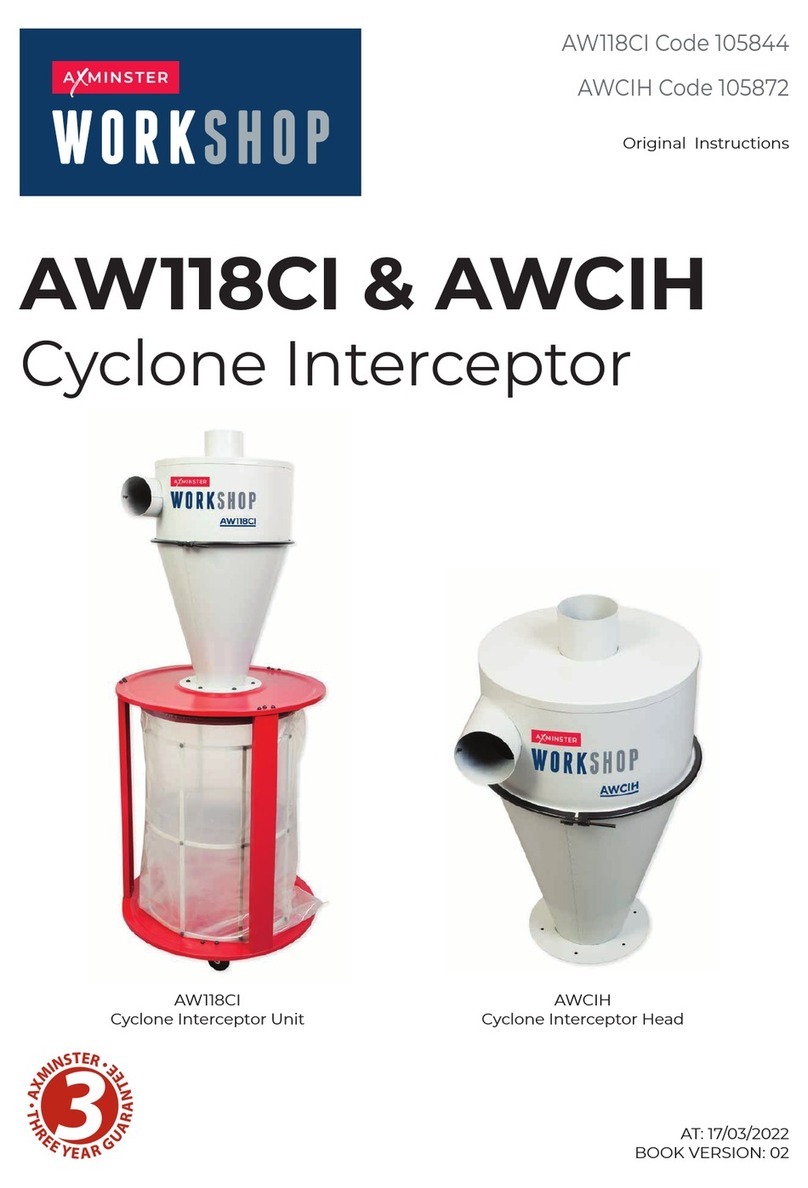
Axminster
Axminster WORKSHOP AW118CI User manual
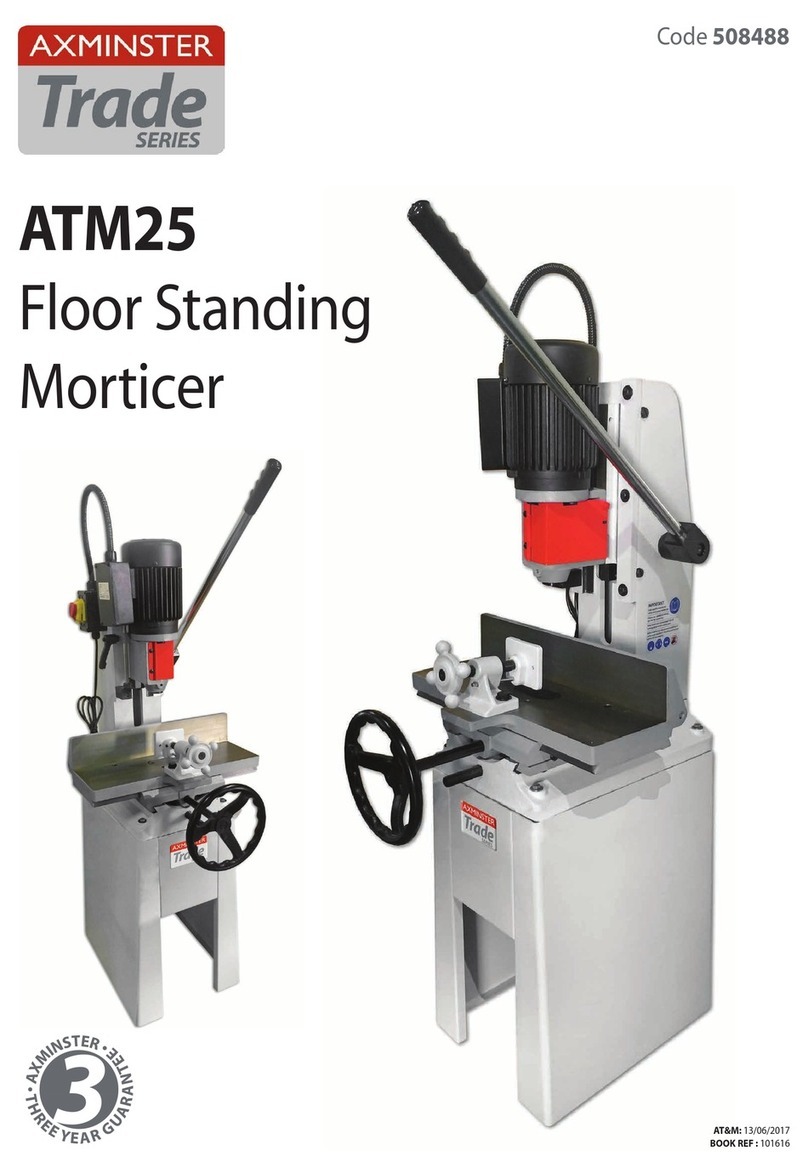
Axminster
Axminster Trade Series User manual
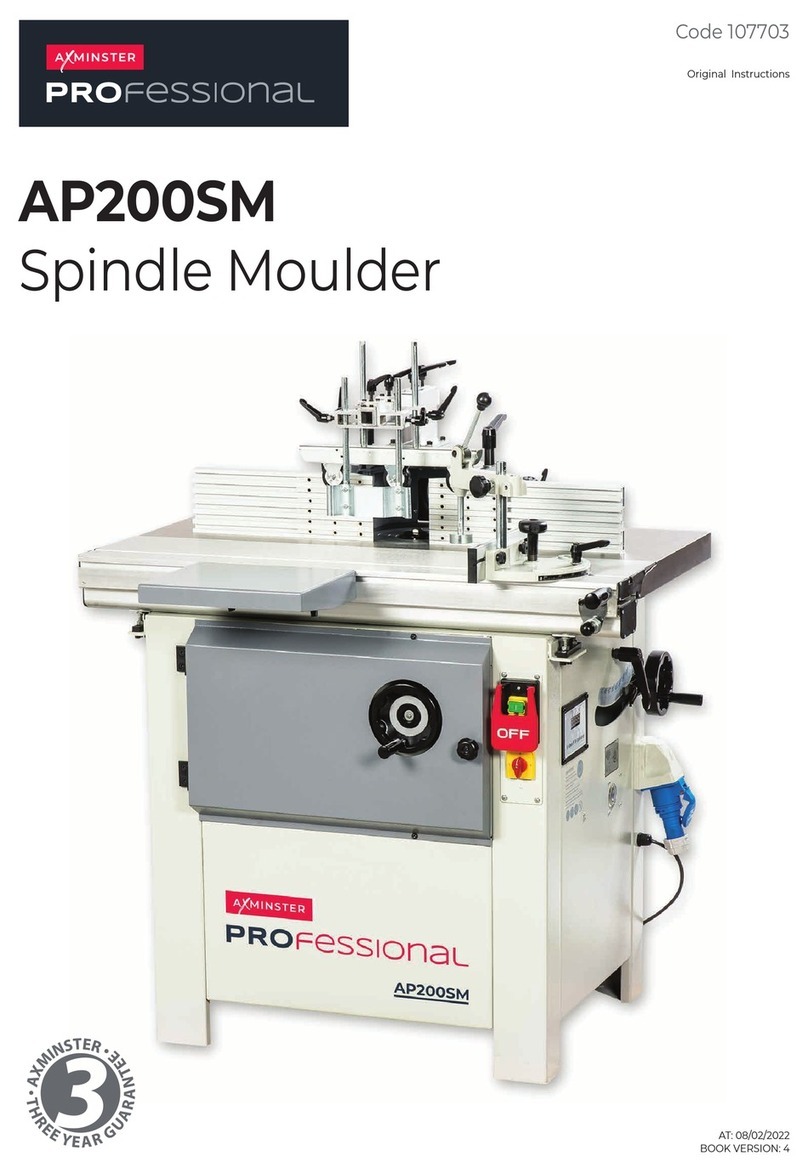
Axminster
Axminster PROFESSIONAL AP200SM User manual
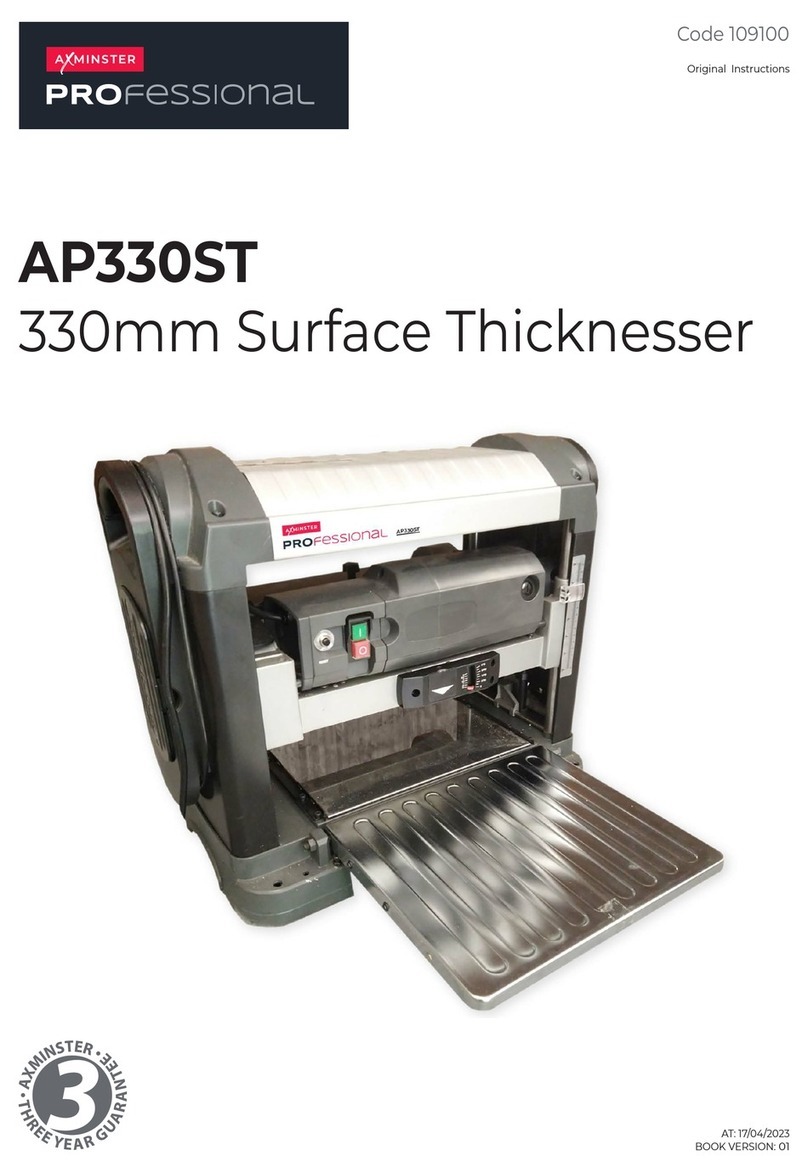
Axminster
Axminster PROfessional AP330ST User manual
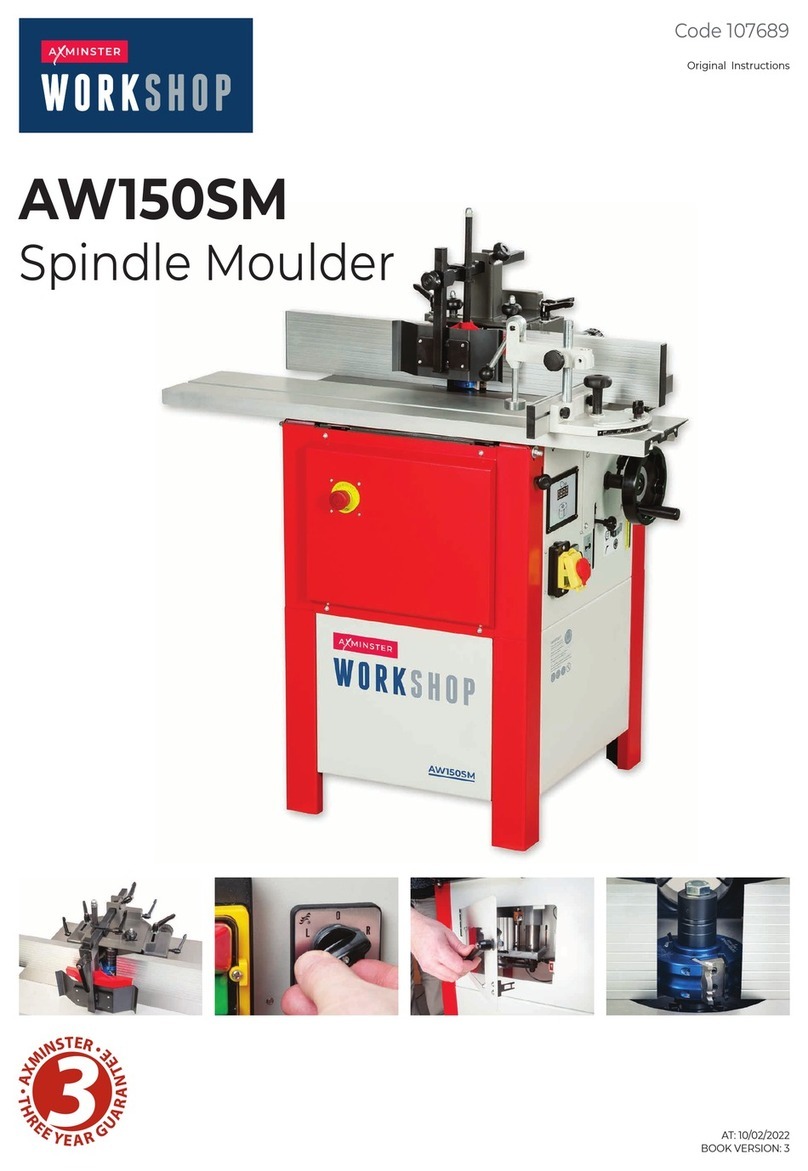
Axminster
Axminster AW150SM User manual
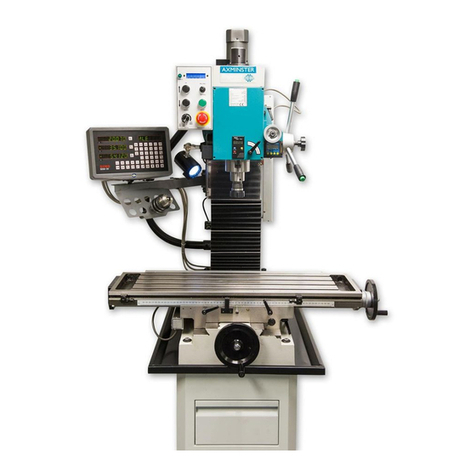
Axminster
Axminster SX4-DIGI User manual
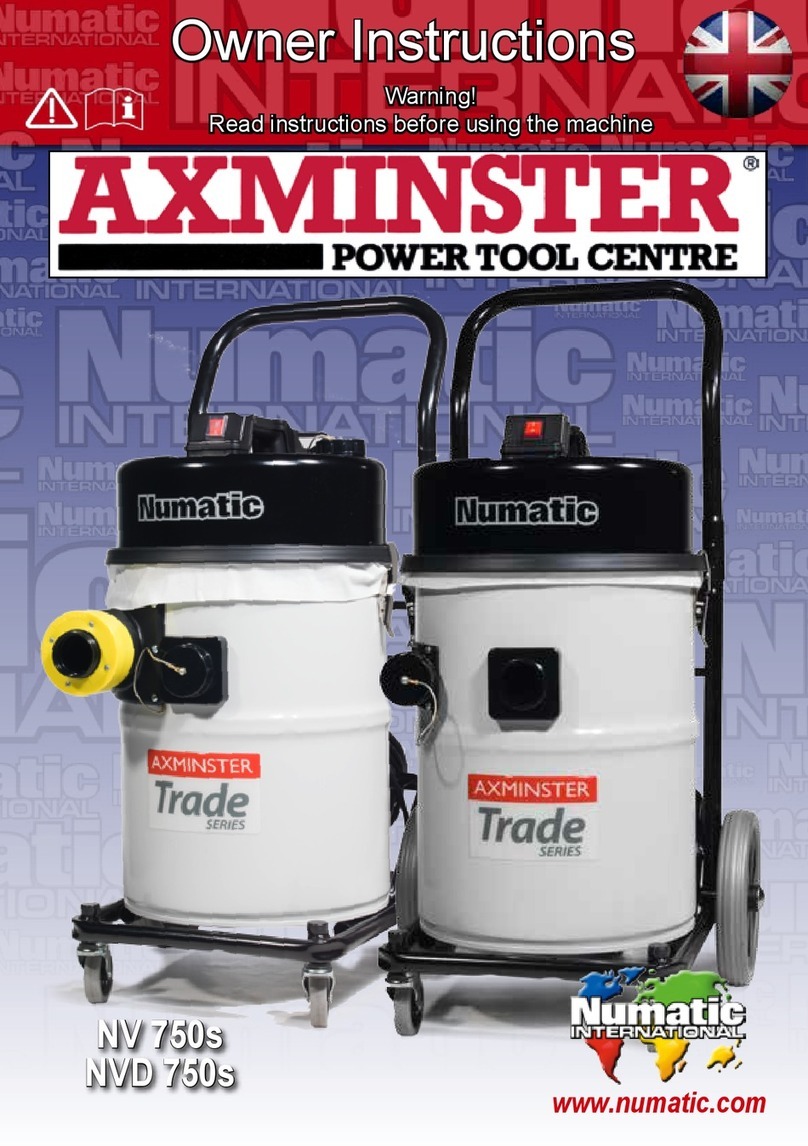
Axminster
Axminster NV 750s User manual

















